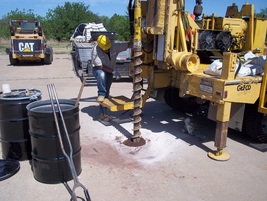Environmental investigations typically evaluate what contaminants are present and their extent in soil and groundwater. Continuous sampling of subsurface soil is often an element in contaminated site investigations because it allows a complete record of the soil column beneath a site.
There are many reasons why this is important, such as, to accurately measure thickness of a petroleum hydrocarbon smear zone or to identify more permeable soil zones that can be pathways for migration of contamination.
What Are The Advantages and Disadvantages of Continuous Coring Methods?
Drilling and continuous coring method examples are described below in terms of overall advantages and disadvantages, and whether they are dry or wet coring methods. Dry coring infers no liquid drilling fluid is used and wet coring infers liquid drilling fluid is used to remove borehole cuttings. Wet coring may introduce unwanted contaminants where environmental samples would be collected.
Push probe:
Advantages are: effectiveness in cohesive soil; rapid progress for less field time; maximized total daily drilling; dual tube systems allow borehole casing; most common dry coring method; cored samples in see-through acetate liners easily accessed for field testing and sampling; investigation derived waste (IDW) is minimized or eliminated.
Disadvantages are: drilling depths less than 75 feet; rocky soil can block sample collection; borehole diameter may be too small for effective or approved monitor wells.
Hollow stem auger:
Advantages are: effectiveness in rocky soil; drilling depths up to 150 feet; continuous core with large diameter 5-foot split spoon sampler; borehole walls stabilized by augers; common dry coring method except in heaving conditions.
Disadvantages are: distortion of sample; slough may occur at top of sample; smearing of borehole walls by drilling can require significant well development effort for clear water; IDW management necessary.
Air rotary:
Advantages are: greater drilling depth; minimized IDW; more effective in rocky soil or bedrock; fairly rapid drilling progress; clean borehole wall; borehole can be cased; continuous soil or rock cores; dry coring method.
Disadvantages are: some IDW and dust management; may be less effective for sampling in low cohesive materials.
Mud rotary:
Advantages over air rotary are: use of drilling fluid for wet coring maintains borehole sidewalls, clears cuttings from drill bit and controls heaving conditions; biodegradable mud is available but chemistry must be known for soil analyses.
Disadvantages are: more IDW management; recirculated drill fluids can introduce contamination from other zones in the borehole.
Sonic:
Advantages are: greater drilling depth; rapid progress for less field time; dry coring method gives clean borehole wall for reduced well development time; continuous borehole casing; minimized IDW.
Disadvantages are: damage to sample from drilling vibration and drilling.
Who Can You Hire For Your Next Drilling Project?
With offices throughout Texas, Oklahoma and New Mexico and decades of combined experience in drilling, Talon/LPE can advise you on which drilling technique is best for your project. Contact our expert team of drilling professionals today for a quote.

